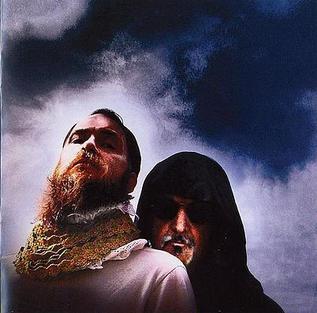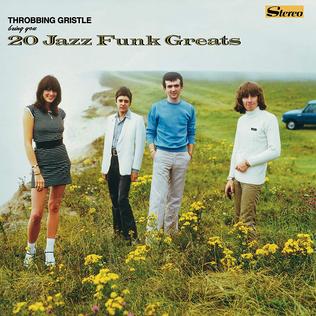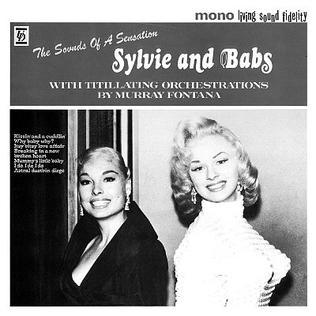Related Research Articles
The cassette culture refers to the practices associated with amateur production and distribution of music and sound art on compact cassette that emerged in the mid-1970s. The cassette was used by fine artists and poets for the independent distribution of new work. This article focuses on the independent music scene associated with the cassette that burgeoned internationally in the second half of the 1970s.
Industrial music is a genre of music that draws on harsh, mechanical, transgressive or provocative sounds and themes. AllMusic defines industrial music as the "most abrasive and aggressive fusion of rock and electronic music" that was "initially a blend of avant-garde electronics experiments and punk provocation". The term was coined in the mid-1970s with the founding of Industrial Records by members of Throbbing Gristle and Monte Cazazza. While the genre name originated with Throbbing Gristle's emergence in the United Kingdom, artists and labels vital to the genre also emerged in the United States and other countries.

Throbbing Gristle were an English music and visual arts group formed in Kingston upon Hull by Genesis P-Orridge and Cosey Fanni Tutti, later joined by Peter "Sleazy" Christopherson and Chris Carter. They are widely regarded as pioneers of industrial music. Evolving from the experimental performance art group COUM Transmissions, Throbbing Gristle made their public debut in October 1976 in the COUM exhibition Prostitution, and released their debut single "United/Zyklon B Zombie" and debut album The Second Annual Report the following year. P-Orridge's lyrics mainly revolved around mysticism, extremist political ideologies, sexuality, dark or underground aspects of society, and idiosyncratic manipulation of language inspired by the techniques of William S. Burroughs.

Cabaret Voltaire were an English music group formed in Sheffield in 1973 and initially composed of Stephen Mallinder, Richard H. Kirk, and Chris Watson. Named for the Zürich nightclub that fostered the early Dada movement, the band are often characterized as among the most innovative and influential electronic acts of their era.

Coil were an English experimental music group formed in 1982 in London and dissolved in 2005. Initially envisioned as a solo project by musician John Balance, Coil evolved into a full-time project with the addition of his partner and Psychic TV bandmate Peter Christopherson. Coil's work explored themes related to the occult, sexuality, alchemy, and drugs while influencing genres such as gothic rock, neofolk and dark ambient. AllMusic called the group "one of the most beloved, mythologized groups to emerge from the British post-industrial scene."

Peter Martin Christopherson was an English musician, video director, commercial artist, designer and photographer, and former member of British design agency Hipgnosis.

Psychic TV were an English experimental video art and music group, formed by performance artist Genesis P-Orridge and Scottish musician Alex Fergusson in 1981 after the break-up of Throbbing Gristle.

Cultural Amnesia (CA) are an English post-punk music group, first active between 1979 and 1983 as participants in the so-called cassette culture of the late 1970s and early 1980s in the UK. During this first period the band released three cassette albums: Video Rideo (1981), The Uncle of the Boot (1983) and Sinclair's Luck (1983) on English and German record labels, and contributed to a number of compilation albums. Early on in his career, CA worked with the late Geff Rushton of Coil, who wrote a handful of songs for them and who was an important supporter and enabler due to his contacts as editor of Stabmental magazine, arranging most of their releases and providing constant encouragement. The band has become more widely known since 2000 following release of a number of compilations of their early '80s music in which the members of the group have been fully involved. Since the late '90s the band has also been occasionally active in the recording of new music and there have been a number of releases of new material since the early 2000s.

Geoffrey Nigel Laurence Rushton, better known under the pseudonyms John Balance or the later variation Jhonn Balance, was an English musician, occultist, artist and poet.

Clock DVA are a musical group from Sheffield, England, whose style has touched on industrial, post-punk, and EBM. They formed in 1978 by Adi Newton and Steven "Judd" Turner. Along with contemporaries Heaven 17, Clock DVA's name was inspired by the Russian-influenced Nadsat language of Anthony Burgess's novel A Clockwork Orange. Dva is Russian for "two".

Chris & Cosey, sometimes known as Carter Tutti, are a musical duo formed in 1981, consisting of couple Chris Carter (electronics) and Cosey Fanni Tutti, both previously members of industrial music pioneers Throbbing Gristle. Since the release of their 1981 debut album Heartbeat, the group have expanded on the rhythmic ideas of Throbbing Gristle while adding synthesized pop elements to their sound.

Eyeless In Gaza is an English musical duo of Martyn Bates and Peter Becker, based in Nuneaton, Warwickshire. They have described their music as "veer[ing] crazily from filmic ambiance to rock and pop, industrial funk to avant-folk styles." Formed in 1980, the group went into hiatus in 1987, re-emerging in 1993.

20 Jazz Funk Greats is the third studio album by British industrial music group Throbbing Gristle, released in December 1979 by the band's Industrial Records label. Known for its tongue-in-cheek title and artwork, it has been hailed as the band's best work, with Fact naming it the best album of the 1970s and Pitchfork naming it the best industrial album of all time.

Unnatural History III, subtitled Joyful Participation in the Sorrows of the World, is the third and final release in the Unnatural History series of compilation albums by British experimental band Coil. Unlike the compilations Stolen & Contaminated Songs and Gold Is the Metal with the Broadest Shoulders, the Unnatural History albums collect songs from more than one era of Coil's work.
Brainwashed is a not-for-profit music website supporting eclectic music. Brainwashed features news, reviews, a podcast, hosts websites for many musical artists and record labels, and has organized two music festivals, Brainwaves. Over fifty people contribute to the archives of Brainwashed. Brainwashed also releases music as Brainwashed Recordings.

The Second Annual Report is the debut album by English industrial music group Throbbing Gristle, released in November 1977 through Industrial Records. It is a combination of live and studio recordings made from October 1976 to September 1977. The Second Annual Report is considered to be influential within electronic music, being one of the first industrial music albums.

D.o.A: The Third and Final Report of Throbbing Gristle is the second studio album by English industrial band Throbbing Gristle, released in December 1978 by their Industrial Records label.
Daniel Otto Joachim Miller is a British music producer and founder of Mute Records.

The Sylvie and Babs Hi-Fi Companion is an album by Nurse With Wound.
Desmadrados Soldados de Ventura is a psychedelic music ensemble formed in Manchester. It features an ever-rotating line-up of musicians who share an admiration for Santana, Royal Trux, Boredoms, Vermonster, Glenn Branca and Funkadelic. The most consistent members between releases have been drummer Andrew Cheetham and guitarists Nick Mitchell and Edwin Stevens. Since 2013, the band have released six full-length studio albums with Golden Lab Records.
References
- ↑ Larkin, Colin, ed. (1995). The Guinness who's who of Indie and new wave. Enfield: Guinness Publishing. p. 280. ISBN 0-85112-657-X.
- ↑ "Stabmental". culturalamnesia.com. Retrieved 18 March 2019.
- ↑ Keenan, David (2016). England's Hidden Reverse. London: Strange Attractor Press. pp. 32, 38–39. ISBN 978-1-907222-17-7.
- ↑ Keenan, David (2016). England's Hidden Reverse. Strange Attractor Press. p. 39. ISBN 978-1-907222-17-7.
- ↑ "Stabmental page at Discogs". discogs.com. Retrieved 18 March 2019.
- ↑ "Discogs page for Murderwerkers". discogs.com. Retrieved 18 March 2019.
- ↑ "Scan of the cover of Stabmental 4/5". tape-mag.com. Retrieved 18 March 2019.
- ↑ "Scan of the cover of The Men with the Deadly Dreams, Stabmental 6". tape-mag.com. Retrieved 18 March 2019.
- ↑ "Discogs page for The Men with the Deadly Dreams". discogs.com. 1981. Retrieved 18 March 2019.
- ↑ Keenan, David (2016). England's Hidden Reverse. Strange Attractor Press. p. 47. ISBN 978-1-907222-17-7.